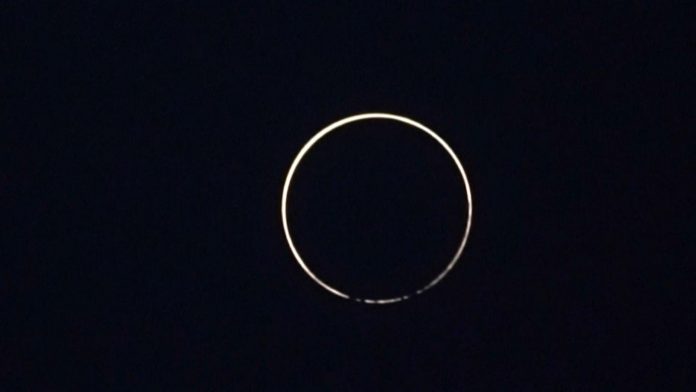The annular eclipse occurs when the moon blocks the center of the sun, leaving only a shining ring of light around the edge – an annulus – often referred to as a “ring of fire”. This form of solar eclipse will only happen twice this century.
Photographers and amateur astrologers have this weekend catalogued an annular solar eclipse drifting along a narrow band from west Africa to the Arabian Peninsula, India and Asia. Annular eclipses occur when the Moon — passing between Earth and the Sun — is not quite close enough to our planet to completely obscure sunlight, leaving a thin ring of the solar disc visible.
These eclipses occur every year or two, and can only be seen from a narrow pathway across the planet.
Sunday’s eclipse coincided with the summer solstice – the Northern Hemisphere’s longest day of the year – when the North Pole is tilted most directly towards the Sun.
The eclipse was first visible in northeastern Republic of Congo from 5.56am local time (5.56am BST) only a few minutes after sunrise.
That was the point of maximum duration, with the blackout lasting a minute and 22 seconds.
Arcing eastward across Africa and Asia, it reached “maximum eclipse” – with a perfect solar halo around the Moon – over Uttarakhand, India, near the Sino-Indian border at 12.10pm local time (7.40am BST).
More spectacular, but less long-lived: the exact alignment of the Earth, Moon and Sun was visible for only 38 seconds.
In Nairobi, East Africa, observers witnessed only a partial eclipse as clouds blocked the sky for several seconds at the exact moment the Moon should have almost hidden the Sun.
Despite some disappointment, Susan Murbana told AFP: “It was very exciting because I think I’m so obsessed with eclipses.
“Today has been very kind to us in terms of the clouds and we’ve been able to see most of it.”
Without the coronavirus pandemic, they would have organised a trip to Lake Magadi in southern Kenya where the skies are generally clearer than over the capital.
She added: “With the pandemic situation, we’re not able to have crowds and get kids to look through or do stuff.”
Florent Delefie, an astronomer at the Paris Observatory revealed the annular eclipse is visible from only about two percent of Earth’s surface.
He said: “It’s a bit like switching from a 500-watt to a 30-watt light bulb.
Super cool view of the Annular Solar Eclipse which passed by our starboard side as we flew over China this morning. A pretty neat way to wake up on Father's Day morning! Hoping all of the dads in the world have a wonderful day! #Eclipse #FathersDay #HappyFathersDay2020 pic.twitter.com/vJx5yOFAcb
— Chris Cassidy (@Astro_SEAL) June 21, 2020
NASA astronaut Chris Cassidy tweeted some fascinating images straight from orbit, showing an amazing view of the annular solar eclipse. According to the astronaut, the crew caught the angle just right as the ISS passed over China in the morning.
Cassidy noted that this was a “pretty neat way to wake up on Father’s Day morning” and congratulated Twitter followers on the holiday.















